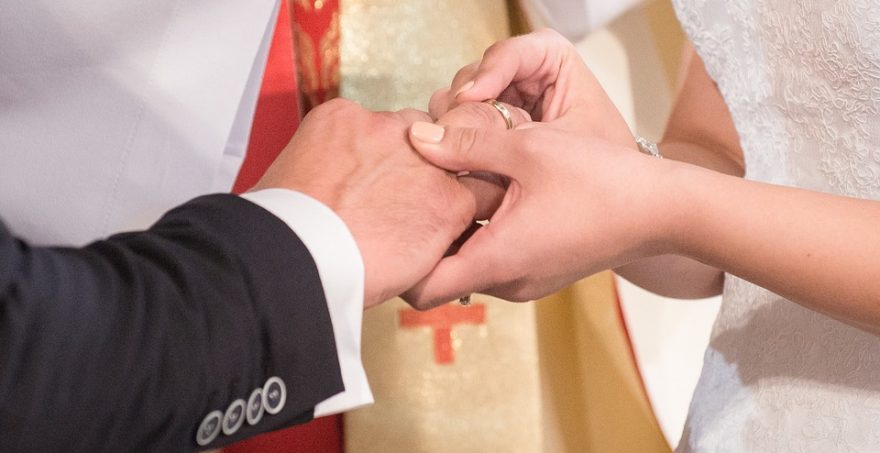

“The engaged couple…should be given catechesis not only about the Church’s teaching on Marriage and the family but also about the Sacrament and its rites, prayers, and readings, so that they may be able to celebrate it thoughtfully and fruitfully.” – Order of Celebrating Matrimony, no. 17
When two Catholics marry, the Sacrament of Matrimony normally takes place within Mass. This is fitting because of the connections all sacraments have with the Paschal mystery of Christ (Catechism of the Catholic Church, no. 1621) and because it is in the Eucharist that Catholic married couples “meet the one who is the source of their marriage” (USCCB, Marriage: Love and Life in the Divine Plan, p. 52). Receiving the Eucharist as their “first meal” together is a beautiful expression of the newlyweds’ reliance on God to sustain and strengthen them throughout their lives.
When the Sacrament of Marriage takes place during Mass, a priest (or a bishop!) is the main celebrant for the ceremony. If other priests or deacons are also able to be present, they may concelebrate or assist as usual at Mass, and could even be invited to preach the homily. In many respects, a wedding Mass is like any other Mass, but with the addition of the ritual for marriage, the heart of which is found in two key moments: the Consent exchanged by the bride and groom, and the Nuptial Blessing that is given to the newly married couple. The consent is “the indispensable element that ‘makes the marriage’” (Catechism, no. 1626). In this moment, the bride and groom are the ministers of the sacrament to each other; the celebrant receives their consent in the name of the Church (see Marriage: Love and Life, p. 33). The beautiful Nuptial Blessing includes an invocation of the Holy Spirit, whom the Catechism describes as the “seal” of the new spouses’ covenant and “the ever-available source of their love and the strength to renew their fidelity” (no. 1624).
In addition to the Consent and the Nuptial Blessing, the Order of Celebrating Matrimony contains two other important elements. Before exchanging vows, the bride and groom are asked a series of questions, called the Questions before the Consent, to determine that each approaches marriage freely, intends a lifelong union, and is open to children and to rearing them “according to the law of Christ and his Church.” Then, after the exchange of vows, there is a Blessing and Giving of Rings. The spouses will wear the blessed rings as a sign of their covenant with each other and with God.
The structure of the ceremony for a Catholic wedding within Mass is outlined below, with various options in parentheses. Engaged couples are encouraged to work together with the celebrant (and perhaps the parish staff) to make their choices for certain texts of the wedding, such as the Scripture readings, the Prayers of the Faithful, and the musical selections. This will help make the wedding liturgy “a profound personal experience” of “full, active and responsible participation” by the bride and groom (Pope Francis, Amoris Laetitia, no. 213; St. John Paul II, Familiaris Consortio, no. 67).
A general outline for a Catholic wedding Mass in the Latin Rite follows, based on the new edition of the Order of Celebrating Matrimony (mandatory to use in the United States as of December 30, 2016). Because there are many options to choose from and various circumstances that can affect the planning of a wedding Mass, it is very important to work with the celebrant or his delegate in arranging the ceremony. Certain details might differ from what is outlined below.
“The marriage liturgy is a unique event, which is both a family and a community celebration. The first signs of Jesus were performed at the wedding feast of Cana. The good wine, resulting from the Lord’s miracle that brought joy to the beginning of a new family, is the new wine of Christ’s covenant with the men and women of every age.” – Pope Francis, Amoris Laetitia, no. 216
Note: The Penitential Act is omitted from a wedding ceremony
In the Liturgy of the Word “are expressed the importance of Christian Marriage in the history of salvation and the responsibilities and duties of Marriage to be attended to for the sanctification of the spouses and of their children.” – Order of Celebrating Matrimony, no. 35.
Note: There may be two or three readings plus the Responsorial Psalm, and at least one of them must explicitly speak of marriage.
“It needs to be stressed that these words [of consent] cannot be reduced to the present; they involve a totality that includes the future: ‘until death do us part.’” – Pope Francis, Amoris Laetitia, no. 214
“The consent by which the spouses mutually give and receive one another is sealed by God himself.” – Catechism of the Catholic Church, no. 1639
“The liturgical crowning of the marriage rite is the Eucharist, the sacrifice of that ‘body which has been given up’ and that ‘blood which has been shed,’ which in a certain way finds expression in the consent of the spouses.” – St. John Paul II, Letter to Families, no. 11
“It is…fitting that the spouses should seal their consent to give themselves to each other through the offering of their own lives by uniting it to the offering of Christ for his Church made present in the Eucharistic sacrifice.” – Catechism of the Catholic Church, no. 1621
Note: after Mass, the witnesses (usually the best man and maid of honor) and priest sign the Marriage record in the vesting room or in the presence of the people, but not on the altar.